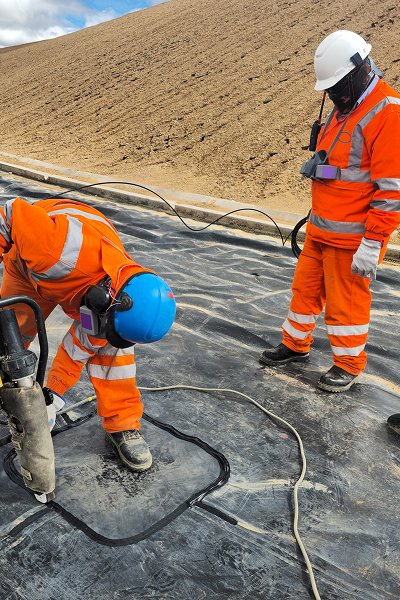What is a drainage board ?
A drainage board is a polymer synthetic material with a three-dimensional spatial support structure. It is generally made of polyethylene (HDPE) or polypropylene (PP) as raw materials. The surface is convex or hollow cylindrical, and has functions such as drainage, ventilation, and root isolation.


Structural basis of drainage board
Drainage board is usually made of HDPE (high-density polyethylene) or PP (polypropylene) materials, and the surface presents different structural forms, such as:
Conical protrusions (hydrophobic columns)
Hollow columnar structure
Grid support

Construct drainage channels
The raised structure of the drainage board naturally forms gaps with the structural surface or the ground when it is laid. After water (such as rainwater, seepage, and groundwater) flows into these gaps, it can be quickly discharged along these gaps:
Vertical drainage: For example, rainwater from the roof or slope seeps from top to bottom and is discharged into the drainage system through the drainage board;
Horizontal drainage: For example, in areas such as the basement outer wall and foundation, water flows horizontally into the drainage channel and then is discharged through the water collection pipe.
Prevent water retention
The rapid drainage ability of the drainage board can prevent water accumulation and avoid the following hidden dangers:
Structural settlement caused by damp foundation;
Long-term immersion of plant roots in water causes rot;
Wall moisture, mold or cracking;
Leachate from landfills pollutes soil and groundwater.
Protect the waterproof layer
Drainage boards are often laid on top of the waterproof layer to form a "buffer layer" on it, which has the following effects:
Resist the pressure of backfill soil or concrete;
Reduce the damage of sharp stones to the waterproof layer;
Disperse the load and increase the life of the waterproof layer.
Water storage function (partial drainage boards)
Some drainage boards are designed in a "cup shape" or "honeycomb shape" to retain some water while draining water:
Provide a slowly released water source for plants;
Balance soil moisture;
Achieve water-saving landscaping.
Main uses of drainage boards
Roof greening system
In roof greening, drainage boards are laid between the waterproof layer and the planting soil to achieve the following functions:
Quickly drain excess water to prevent plant roots from rotting due to water accumulation
Form a water storage space to provide the water needed by plants
Protect the waterproof layer and extend the service life of the roof
Underground engineering drainage
Drainage boards are commonly used in basement exterior walls, underground garage roofs, etc., and have the following uses:
Prevent groundwater from seeping into the structure
Improve drainage efficiency around the structure and reduce soil pressure
Use in combination with geotextiles to prevent mud and sand from blocking the drainage channel
Highway and railway slope protection
In highway, railway slopes, retaining walls and other fields, drainage boards are used as drainage layers to have the following functions:
Slow down slope sliding caused by rainwater erosion
Remove excess water from the slope soil and enhance structural stability
Reduce soil pore water pressure and extend slope life
Landfill anti-seepage drainage system
In landfills, drainage boards are widely used in anti-seepage systems, and are combined with geomembranes and geotextiles to form a composite drainage structure:
Discharge leachate to prevent groundwater pollution
Reduce the water pressure load of the anti-seepage membrane
Improve drainage efficiency and reduce maintenance costs




Advantages of drainage board
Convenient construction and high efficiency; drainage board is lightweight, in roll or sheet form, easy to transport, simple to lay, greatly shortening the construction period.
Significant drainage effect; structural design optimizes drainage channel, not only fast drainage speed, but also effectively prevents blockage.
Stable structure, pressure resistance and impact resistance; high-strength plastic material gives it good compression resistance, adapting to complex geology and long-term load.
Energy saving and environmental protection; drainage board uses recyclable materials, which conforms to the environmental protection concept of modern green buildings.
Common problems and solutions for drainage boards
Blockage problem
Reason: The use environment has more fine-grained soil or plant roots
Solution: Add a filter layer and use non-woven geotextile to wrap the drainage board
Deformation or collapse
Reason: The backfill soil pressure is too large or uneven
Solution: Reasonable backfill, layered compaction, and use reinforced drainage boards
Reduced lifespan
Reason: Low-quality materials or long-term exposure to ultraviolet rays
Solution: Use high-quality HDPE materials to avoid exposed paving
Drainage board is a new auxiliary material. It can be used in urban roads, green gardens, underground projects, landfills, drainage, protection, root isolation, ventilation, water storage and other key functions. Choosing high-quality drainage board can improve the quality of the project and extend the life of the building, achieving a win-win situation of ecology and efficiency.
If you are looking for drainage board products or related technical services, please contact our professional team, we will provide you with customized solutions


